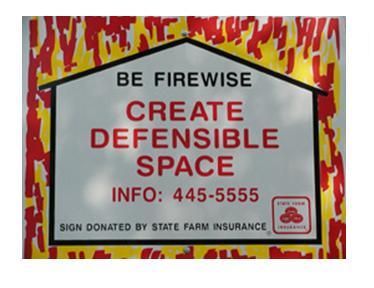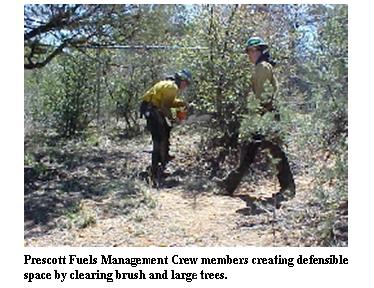|
Home |
Search the Database |
Display Index |
Contact Us |
Database Login
|
The national database of state and local wildfire hazard mitigation programs
serves as a clearinghouse of information about nonfederal policies and
programs that seek to reduce the risk of loss of life and property through
the reduction of hazardous fuels on private lands. If
you would like to submit a program to the national wildfire programs database,
please complete the following form (MS
Word).
Return to your search results or Perform a new search
|
Title: |
Prescott, AZ -- Wildland-Urban Interface Commission
|
|
Type: |
Homeowner assistance
Fuelbreaks
Education
Community Planning
|
|
Jurisdiction: |
Multi-level
|
|
State: |
Arizona
|
|
Program Description: |
The Prescott Area WUI Commission (PAWUIC) is comprised of volunteers and cooperating agencies in the Prescott Basin area. The Commission is supported by representatives from the City of Prescott, County of Yavapai Emergency Management, Prescott Fire Department, Central Yavapai Fire District, Arizona Department of Forestry, Prescott National Forest and Bureau of and Management. The PAWUIC was formed in 1990 by a joint resolution of the County of Yavapai Board of Supervisors and the City of Prescott, mayor and council. The PAWUIC has been very active in educating residents to live safely in high fire hazard areas and has coordinated community planning efforts for hazardous fuel reduction and defensible space projects.
Goals of the Commission
- Advise the cooperating agencies
- Identify, develop, prioritize and address wildland/urban interface issues facing citizens
- Develop plans and actions for management of identified issues and make recommendations to appropriate levels of government
- Promote the development of citizen awareness of interface issues and initiatives
- Pursue the development of agreements among owners and operators of private land in order to implement plans and actions in a timely manner
- Provide the cooperating agencies with a quarterly report on Commission activities and progress.
Education
The Commission has been very active in firewise education and public outreach. These efforts have included the publication and dissemination of educational materials, public meeting for residents, annual town hall meeting on fire safety and awareness, and press releases -- declarations of a "Firewise Month" by both the City of Prescott and Yavapai County have helped draw audiences to public meetings.
Community awareness efforts have included the placement of signs that read �Be Firewise: Create Defensible Space� along major roads. In addition, a website, http://www.regionalinfo-alert.org/, has been established to inform local citizens of events in the Interface such as prescribed fire and emergency events as they occur. Classroom education is the focus of a cooperative program between the Commission and the University of Arizona Extension Service that incorporates the Firewise message in the Project Learning Tree environmental education curriculum.
The Commission also sponsored a conference, �Living on the Edge: The Challenge of Wildland Development in the Prescott Area� that involved a wide-range of attendees including representatives from local, state, and federal agencies; developers, insurance company and homeowner association representatives.
Collaboration
A subgroup of the Commission has concentrated on improving cooperation between all the area's fire agencies. New procedures and training techniques have been put in place. Joint exercises -- both "on-the-ground" and "table-top" were used to test these procedures. The Commission also played a role in Prescott's adoption of a new urban/wildland fire code.
Fuels Treatment
Slash disposal has been a problem in the Prescott Basin. While many residents are cooperative in reducing hazardous fuels, they are generally not willing to pay what they believe are unreasonably expensive disposal costs at the regional landfill. In addition, burying or burning waste biomass in this high desert community is considered unacceptable.
To address the disposal issue, the Commission purchased a portable commercial chipper to provide chipping services for homeowners. This was accomplished through a state grant that paid half the cost with the City of Prescott and civic organizations paying the remaining balance.
In 2001 the Commission received $160,000 in a 50/50 matching grant through the State Fire Assistance Program under the National Fire Plan. The largest part of these funds went to support work crews that remove brush and other fuel loads from private residences, at no or low cost to the property owner. Subsequent grants obtained in 2002, 2003 and 2004 enabled the program to continue.
In 2002, a second chipper was purchased and a second brush crew added to the program. After three years of these fuels reduction operations, 5,250 of the highest risk properties in the Prescott Basin have been treated. That equates to 7,000 acres and 12,500 citizens � about 25 percent of the desired treatments.
Community support has been invaluable in treating high-risk properties. The Prescott Fire Department and the Central Yavapai Fire District provided matching funds for brush crew salaries. Further support came from "in kind" equipment donations from Arizona Public Service and equipment maintenance performed by Yavapai County. State Farm Insurance Company also contributed to chipper purchases and underwrote the �Firewise� signs seen around the Prescott Basin.
Community Fire Protection Planning
The PAWUIC�s Interagency Fire and Emergency Management Group (IFEMG) have coordinated the development of the Yavapai Community Wildfire Protection Plan (YCWPP). The purpose of the CWPP is to guide and prioritize wildfire safety projects for Prescott and surrounding communities. Fourteen separate fire departments/districts have been involved in its development. The area encompassed by the plan covers almost one million acres and $6.6 billion in valuation. The document includes 250 pages of text, maps and aerial photographs. Maps were prepared by the Yavapai County Assessor�s Office. This will be an on going program monitored by an Administrative Oversight Committee. The plan can be viewed at the Yavapai Communites Wildfire Protection Plan website.
Biomass Utilization
In 2004, the Commission completed a study of the economic implications of local fuel reduction programs. The Healthy Forest Economic Development Team (HFEDT) was formed within PAWUIC to encourage the development of a sustainable local forest products industry.
The HFEDT representatives include the City of Prescott, Yavapai County, the Yavapai College agribusiness operation and local entrepreneurs. The emphasis is on businesses scaled to local forest yields of various types of biomass. Identified businesses in various stages of development include small-scale milling operations, power generation and commercial heating projects, and wood pellet production.
Contact Information
For more information visit the website, www.PAWUIC, or contact Ken Iversen, Commission Chair, at [email protected].
|
|
Images: |
|
1. | 
|
|
|
|
2. | 
|
|
|
|
|



